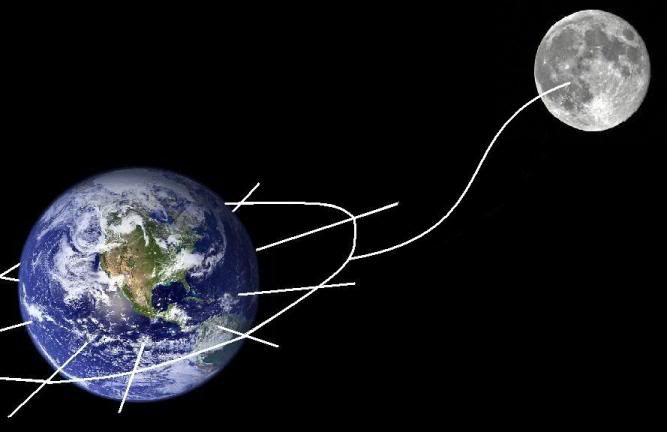You know those nifty space-elevators you've heard of? Imagine a dozen or so of those things evenly spaced around the Earth's equator. I know that would be tricky since so much of the equator crosses the ocean, but nothing else about this proposal is going to be easy either, so just accept it.
Now imagine a giant ring connecting all of these elevators at the height of geostationary orbiting satellites (35,786 km). Another elevator connects to this ring, but instead of going down to the Earth it starts at the ring and extends outward. The connection with the outward-bound elevator moves along the ring from east to west so that to an outside observer it remains relatively stationary while the Earth rotates under it once every 24 hours.
The other end of this secondary elevator is rooted in surface of the nearside of the moon. The elevator is flexible, to account for the fact that the moon does not orbit in the exact same plane as the earth's equator. It can also collapse in on itself like a spyglass so that it can shorten to 350,000 km or lengthen to 410,000 km to account for the fact that the moon is closer to the earth at perigee than at apogee.
Imagine climbing into a comfortable compartment on the earth's surface, which automatically rides up to the ring, moves onto the ring, slowly accelerating from east to west until travelling approximately 11000 kilometers per hour, rendezvousing with the second connection, and spending the next day or so travelling in fun zero-G to your vacation destination: Hotel Luna.
Here is my obviously not-to-scale diagram:

I know it's crazy, but is it any more so than a Dyson sphere?
Now imagine a giant ring connecting all of these elevators at the height of geostationary orbiting satellites (35,786 km). Another elevator connects to this ring, but instead of going down to the Earth it starts at the ring and extends outward. The connection with the outward-bound elevator moves along the ring from east to west so that to an outside observer it remains relatively stationary while the Earth rotates under it once every 24 hours.
The other end of this secondary elevator is rooted in surface of the nearside of the moon. The elevator is flexible, to account for the fact that the moon does not orbit in the exact same plane as the earth's equator. It can also collapse in on itself like a spyglass so that it can shorten to 350,000 km or lengthen to 410,000 km to account for the fact that the moon is closer to the earth at perigee than at apogee.
Imagine climbing into a comfortable compartment on the earth's surface, which automatically rides up to the ring, moves onto the ring, slowly accelerating from east to west until travelling approximately 11000 kilometers per hour, rendezvousing with the second connection, and spending the next day or so travelling in fun zero-G to your vacation destination: Hotel Luna.
Here is my obviously not-to-scale diagram:

I know it's crazy, but is it any more so than a Dyson sphere?



